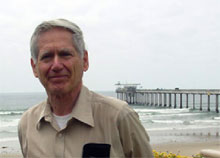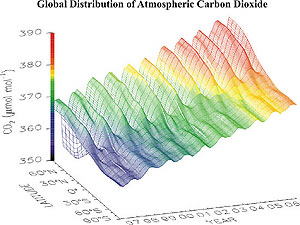 The National Oceanic and Atmospheric Administration (NOAA), Scripps Institution of Oceanography (SIO), and numerous other partners celebrated the fiftieth anniversary of the global atmospheric carbon dioxide record in Kona, Hawaii in November 2007. When Dr. Charles David Keeling of SIO began his struggle to obtain support for a newly developed, high precision, high accuracy approach for measuring atmospheric carbon dioxide in 1957, it was hard to imagine how invaluable his efforts and accomplishments would be today. Data from a vast, globally distributed network now provide the basis of our understanding of the relationship of the role and impact of carbon dioxide and other greenhouses in global climate. This data record, and how the network evolves, will be critical to society’s having the information it needs to make decisions regarding global climate change and how best to adopt adaptation and mitigation strategies.
The National Oceanic and Atmospheric Administration (NOAA), Scripps Institution of Oceanography (SIO), and numerous other partners celebrated the fiftieth anniversary of the global atmospheric carbon dioxide record in Kona, Hawaii in November 2007. When Dr. Charles David Keeling of SIO began his struggle to obtain support for a newly developed, high precision, high accuracy approach for measuring atmospheric carbon dioxide in 1957, it was hard to imagine how invaluable his efforts and accomplishments would be today. Data from a vast, globally distributed network now provide the basis of our understanding of the relationship of the role and impact of carbon dioxide and other greenhouses in global climate. This data record, and how the network evolves, will be critical to society’s having the information it needs to make decisions regarding global climate change and how best to adopt adaptation and mitigation strategies.
PAST
During the International Geophysical Year (IGY;1957-58) and one year following the dedication of the Mauna Loa Observatory (MLO), Dr. Keeling began measuring atmospheric carbon dioxide at Mauna Loa, Hawaii, and the South Pole, Antarctica. At the time of Dr. Keeling’s initial efforts, little was known of carbon dioxide (CO2) in the atmosphere and no reliable atmospheric record existed. Indeed, many scientists were not certain that one could detect meaningful patterns such as seasonal changes, hemispheric differences, and fossil fuel emissions with measurements of such a low-concentration constituent of the atmosphere records we now take for granted and have used for achieving a far greater understanding of the Earth system as a whole. The early measurements by Dr. Keeling began what was to become a coordinated global monitoring network involving scientists and agencies from countries around the world. Information derived from this network, which now includes many greenhouse gases, isotopes, and other tracers, has been crucial for informing national and international assessments of global climate change, not the least of which are the International Panel on Climate Change (IPCC) assessment reports.
 PRESENT
PRESENT
Today, Dr. Keeling’s records at Mauna Loa and the South Pole are still maintained and have been augmented substantially by NOAA and others since the 1970s, with parallel measurements at these sites and a global network of over 60 sites where continuous or weekly measurements are made. International partners from all continents and many islands contribute to this network of measurements, now under the umbrella of the World Meteorological Organization (WMO Global Atmospheric Watch). Measurements made as part of this network are subject to stringent quality control procedures and are archived in globally distributed repositories, including the World Data Centre for Greenhouse Gases in Japan and the Carbon Dioxide Information and Analysis Center at Oak Ridge, Tennessee.
 Of the many sites participating in the global network, MLO is best known for its record of the continuous rise of carbon dioxide in Earth’s atmosphere. Carbon dioxide measurements conducted at Mauna Loa continue to form the backbone of this global network to inform global society on the state of our changing planet. Since the early IGY efforts, research at MLO has expanded to studying the trends of more than 50 chemical species in Earth’s atmosphere, an effort involving over 40 partners from around the world. Measurements conducted at the site today are widespread and have global significance for climate, stratospheric ozone depletion, and baseline air quality. Research organizations from around the world participate in programs at MLO in order to measure greenhouse gases, aerosols, solar radiation, and other atmospheric properties and constituents. MLO is one of the premier, long-term, atmospheric monitoring facilities on Earth, and this record may very well be the singular guide for collective societal action well into the next century.
Of the many sites participating in the global network, MLO is best known for its record of the continuous rise of carbon dioxide in Earth’s atmosphere. Carbon dioxide measurements conducted at Mauna Loa continue to form the backbone of this global network to inform global society on the state of our changing planet. Since the early IGY efforts, research at MLO has expanded to studying the trends of more than 50 chemical species in Earth’s atmosphere, an effort involving over 40 partners from around the world. Measurements conducted at the site today are widespread and have global significance for climate, stratospheric ozone depletion, and baseline air quality. Research organizations from around the world participate in programs at MLO in order to measure greenhouse gases, aerosols, solar radiation, and other atmospheric properties and constituents. MLO is one of the premier, long-term, atmospheric monitoring facilities on Earth, and this record may very well be the singular guide for collective societal action well into the next century.
 FUTURE
FUTURE
Though the half-century-long record of atmospheric carbon dioxide concentration has been critical in understanding the role that this major greenhouse gas plays in the global energy budget, future measurement systems must be carefully designed and deliberately implemented to support society’s decisions in a context in which climate change is increasingly relevant. The global network as designed has been successful in providing answers to many scientific questions regarding the relationship between atmospheric CO2 and global climate change, yet critical questions in the future may require changes in network sampling design, use of additional or different techniques of measurement, closer integration of modeling and measurement, and augmentation of the measurement system. The nature of this system will depend upon the questions being asked, the approaches being taken to address increasing CO2 emissions, and the scope of the global effort. The 50th Anniversary of the Global Carbon Dioxide Record Symposium and Celebration briought together leaders in business, government, and science to discuss efforts being made to manage carbon dioxide today, what efforts are likely for the future, and what research will be needed to support those efforts.

